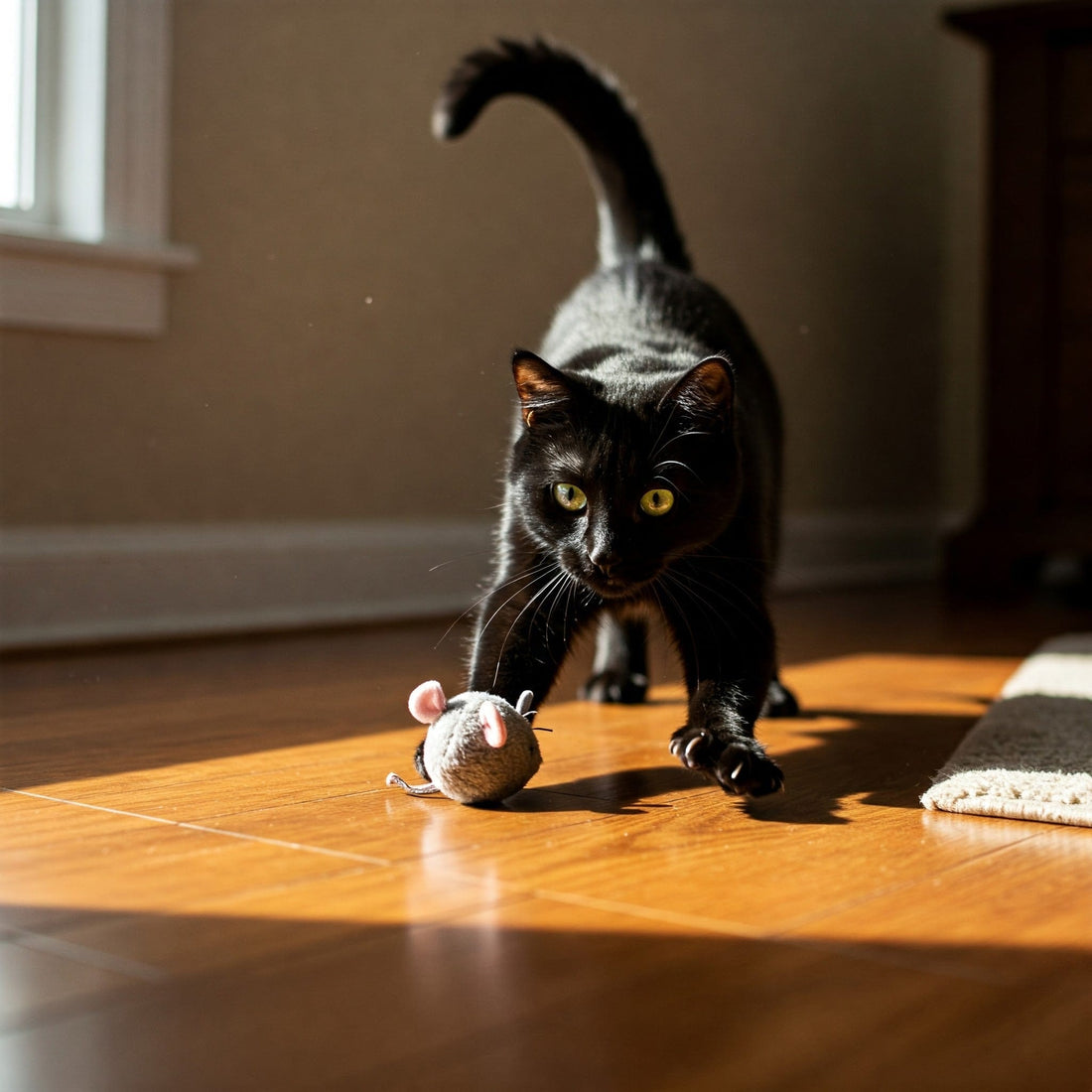
Understanding Predatory Play in Domestic Cats
Share
The moment your cat's pupils dilate into black saucers, their body lowers into a crouch, and their tail twitches with electric anticipation, you're witnessing an ancient ritual unfolding in your modern home. That stuffed mouse isn't just a toy—it's become prey in your feline's mind, triggering instincts honed over millions of years of evolution. Domestic cats may no longer need to hunt for survival, but their brains remain wired for the chase, the pounce, the kill. This predatory play isn't mere entertainment; it's a biological imperative that shapes your cat's physical health, mental wellbeing, and even their bond with you. Understanding these deep-seated drives transforms playtime from a casual distraction into a vital component of feline care, fulfilling needs that kibble-filled bowls and cozy beds cannot.

Is my cat playing or being aggressive?
Predatory behavior in cats follows an immutable sequence hardwired into their nervous systems: stare, stalk, chase, pounce, kill, and finally, eat. Each phase serves a specific evolutionary purpose, and domestic cats compulsively complete this chain even during play. The initial fixation phase—that intense stare your cat gives a toy or fluttering curtain—activates their visual cortex in ways remarkably similar to wild felids observing actual prey. During this stage, cats enter a hyper-focused state where minor muscle tremors ripple through their hindquarters, preparing for explosive movement. Modern imaging shows their brains flooding with dopamine during this anticipation, creating a reward loop that explains why cats will "hunt" the same toy repeatedly without tiring of the game.
The stalk that follows is a masterpiece of biomechanical efficiency. Your cat's body lowers until their belly fur brushes the floor, hind legs coiling like springs while their weight shifts subtly from side to side. This movement pattern conserves energy while maintaining readiness to attack—an adaptation from ancestors who needed to pursue prey across long distances without alerting their target. Domestic cats retain this energy-saving technique even when "hunting" a feather wand just feet away. Their paw placement becomes precise during the stalk, with each step carefully rolling from toe to heel to minimize noise, a behavior useless on modern carpet but perfected on the leaf-littered forest floors of their wild predecessors.
The chase itself varies by individual cat's hunting style, largely determined by early life experiences. Cats who had outdoor access as kittens typically demonstrate more sophisticated chase techniques—alternating between rapid bursts and freezing, using environmental cover, and anticipating prey movement. Indoor-raised cats often show less refined but more enthusiastic chasing behaviors, sometimes overcommitting to pounces or losing interest if the "prey" doesn't behave realistically. This difference highlights the critical learning period between four and sixteen weeks when kittens refine their skills through observation and practice with littermates. Cats deprived of appropriate play during this window may never develop proper predatory coordination, explaining why some cats seem clumsy or disinterested in play.
The pounce represents the predatory sequence's most dramatic moment, where potential energy converts to kinetic force. Watch closely and you'll see your cat's hind feet push off asymmetrically—the right paw providing power while the left steers—an adaptation for correcting mid-air trajectory when prey changes direction. Their forelegs extend with claws unsheathed not just to grab, but to deliver the signature feline killing bite to the neck. Domestic cats often inhibit this bite during play, but the head-shaking motion they use with toys mimics the wild behavior used to snap prey's spines. This explains why cats prefer toys they can grip between their front paws while "killing"; it satisfies the neurological imperative to complete the sequence.
Post-kill behaviors in play reveal just how deeply ingrained these patterns remain. The triumphant parade with a toy in mouth, the cautious glances for potential thieves, the settling down to "pluck" imaginary fur or feathers—these are all hardwired behaviors with no practical purpose in domestic life. Some cats even engage in pseudo-maternal behavior afterward, grooming their toy as wild mothers clean cubs after a hunt. This completion ritual appears crucial for feline satisfaction; interrupted play leaves cats visibly frustrated, often leading to redirected aggression or obsessive behaviors.
The role of prey movement cannot be overstated in triggering these instincts. Studies using robotic prey demonstrate that cats respond most vigorously to movements mimicking injured animals—erratic but slowing, with occasional twitches that simulate dying throes. The most effective toys replicate this pattern: quick darting motions followed by pauses, changes in direction, and finally weakening movement. Laser pointers famously frustrate cats because they violate this natural progression, disappearing without allowing the critical kill phase. This explains why cats frequently return to stare at the last laser spot—their brain awaits closure to the hunting sequence.
Age dramatically influences predatory play styles. Kittens engage in exaggerated, often clumsy play as they develop coordination and strength. Their play incorporates more social elements too, practicing skills they'd use against littermates. Adolescent cats (6-18 months) display the most intense predatory behaviors, with higher jumps and more persistent chases. Adults tend toward shorter, more efficient play sessions unless deprived of outlets for their energy. Senior cats often retain strong predatory drives but modify techniques to accommodate stiff joints—ground-based stalking replaces aerial acrobatics, and play sessions shorten but remain crucial for mental stimulation.
Multi-cat households present unique predatory play dynamics. Cats may engage in cooperative hunting behaviors rarely seen in solitary wild felines, taking turns chasing or flanking toys. Others compete intensely, requiring separate play sessions to prevent conflict. Observing which cats prefer which roles (stalker vs ambusher) helps tailor play to their natural inclinations. Some cats even develop specialized techniques—one might excel at high leaps while another prefers stealthy ground approaches—suggesting individual "hunting personalities" persist despite domestication.
The physical benefits of proper predatory play are profound. The explosive movements build fast-twitch muscle fibers crucial for feline athleticism. The sudden direction changes maintain joint flexibility and proprioception. Even the intense focus during stalking exercises their visual tracking abilities, potentially slowing age-related cognitive decline. Indoor cats particularly require this physical outlet; without it, they risk obesity, arthritis from underuse, and the frustration that leads to destructive behaviors.
Mental health depends equally on satisfying these instincts. Cats deprived of appropriate predatory outlets often develop anxiety, overgrooming, or obsessive behaviors. The act of "killing" toys appears to trigger endogenous opioid release, providing natural stress relief. Play also helps cats process environmental stressors—after encountering outdoor cats through windows, appropriate play can discharge that pent-up territorial energy productively. The concentration required during hunting play may even help cats with compulsive disorders by redirecting their focus.
Humans play a pivotal role as hunt facilitators. Your movements mimicking prey behavior directly influence the quality of your cat's predatory experience. Dragging toys in straight lines or predictable patterns fails to engage their full cognitive abilities. Instead, incorporate hiding behaviors—making toys disappear under blankets or behind furniture to trigger searching behaviors. Vary speeds and directions, but always allow the "kill" and provide a food reward afterward to complete the cycle. This mimics the hunt-eat-groom-sleep sequence wild cats follow, leaving your cat truly satisfied rather than frustrated.
Toy selection makes or breaks predatory play. The best toys share key prey characteristics: they're small enough to grip between paws (mouse-sized), have erratic movement potential, and make subtle sounds (crinkles, light bells). Feather wands excel because they mimic bird wingbeats when fluttered correctly. Kicker toys satisfy the bunny-kick killing motion used on larger prey. Even simple crumpled paper balls work when thrown unpredictably. Rotate toys weekly to prevent habituation; cats lose interest in static "prey" that never changes.
Recognizing play aggression is crucial. Overstimulated cats may redirect predatory behaviors onto human hands or feet—a dangerous pattern to encourage. Immediate redirection to appropriate toys teaches boundaries. Similarly, cats frustrated by incomplete hunt cycles may bite owners; always conclude play sessions with a satisfying "kill" and small food reward. Kittens especially need guidance to inhibit bite strength during play, learning through gentle feedback when they cross lines.
Environmental enrichment extends play's benefits. Window perches allowing bird watching engage their visual hunting instincts. Food puzzles force cats to "work" for meals, activating problem-solving skills. Even something as simple as hiding portions of their daily kibble around the house creates scavenging opportunities. These activities are particularly vital for indoor cats lacking natural hunting outlets.
Health conditions can alter predatory behaviors. Arthritis may reduce jumping ability but increase ground-based stalking. Hyperthyroidism sometimes causes play aggression or restlessness. Dental pain may make cats reluctant to carry toys. Sudden changes in play habits often signal medical issues needing veterinary attention. Conversely, appropriate play aids recovery from many conditions by maintaining muscle tone and mental engagement during convalescence.

Breed tendencies influence play styles. High-energy breeds like Bengals and Abyssinians often display more sophisticated predatory sequences and require longer play sessions. Persians and other brachycephalic breeds may prefer ground-based play due to breathing limitations. Understanding your cat's innate tendencies helps tailor play to their natural abilities and needs.
Play's role in human-feline bonding cannot be overstated. When you engage your cat's predatory instincts through proper play, you speak their primal language. The trust built during these sessions carries over into all aspects of your relationship. Cats who view their humans as skilled hunt facilitators often show greater affection, more relaxed behavior, and fewer stress-related issues.
Ultimately, understanding predatory play means recognizing that your domestic cat remains, at heart, a perfectly evolved hunter. Their need to chase and "kill" is as fundamental as their need for food or shelter. By providing appropriate outlets for these behaviors, we honor their true nature while keeping them safe in our human world. The cat sprawled purring on your lap after a good play session isn't just relaxed—they're fulfilled in ways that transcend their domesticated existence, connected to the wild ancestors that still live in their muscles, nerves, and dreams.


